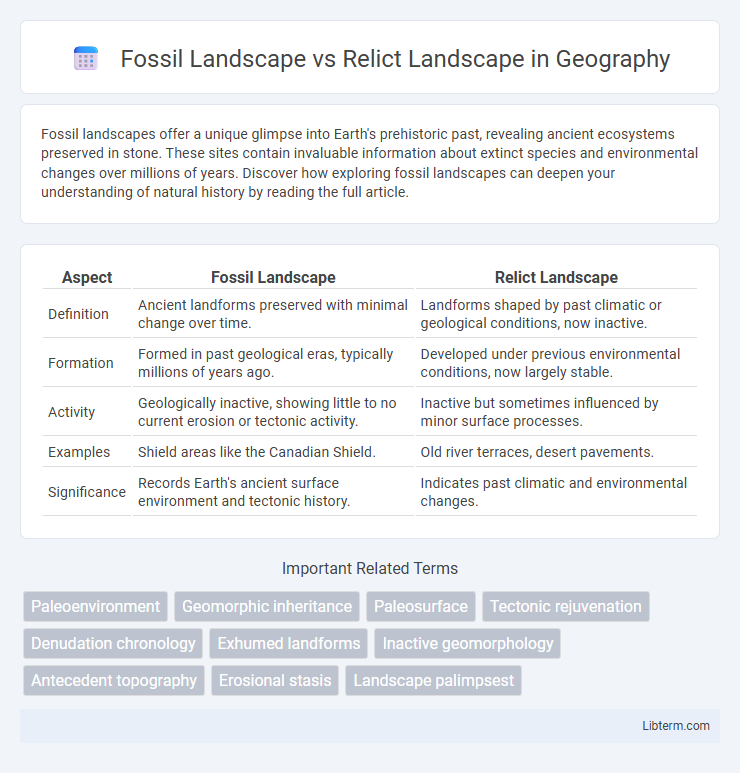Fossil landscapes offer a unique glimpse into Earth's prehistoric past, revealing ancient ecosystems preserved in stone. These sites contain invaluable information about extinct species and environmental changes over millions of years. Discover how exploring fossil landscapes can deepen your understanding of natural history by reading the full article.
Table of Comparison
| Aspect | Fossil Landscape | Relict Landscape |
|---|---|---|
| Definition | Ancient landforms preserved with minimal change over time. | Landforms shaped by past climatic or geological conditions, now inactive. |
| Formation | Formed in past geological eras, typically millions of years ago. | Developed under previous environmental conditions, now largely stable. |
| Activity | Geologically inactive, showing little to no current erosion or tectonic activity. | Inactive but sometimes influenced by minor surface processes. |
| Examples | Shield areas like the Canadian Shield. | Old river terraces, desert pavements. |
| Significance | Records Earth's ancient surface environment and tectonic history. | Indicates past climatic and environmental changes. |
Introduction to Fossil and Relict Landscapes
Fossil landscapes are ancient landforms preserved from past geological processes, often buried or exposed through erosion, showcasing historical environmental conditions. Relict landscapes represent remnants of former land surfaces that have survived extensive weathering and erosion, maintaining features indicative of previous geomorphic regimes. Both fossil and relict landscapes provide crucial insights into Earth's evolutionary history and environmental changes over geological time.
Defining Fossil Landscapes: Key Characteristics
Fossil landscapes are geological formations that preserve ancient landforms and features shaped by past environmental conditions, often buried and protected from subsequent erosion or modification. Key characteristics of fossil landscapes include their static nature, the presence of well-preserved geomorphological features such as old river channels, dunes, or soil horizons, and their ability to provide valuable insight into Earth's paleoenvironmental history. Unlike relict landscapes, fossil landscapes offer a snapshot of former surface conditions that have remained largely unchanged due to tectonic stability and sedimentary cover.
Understanding Relict Landscapes: Main Features
Relict landscapes are geomorphic features that have survived from an earlier geological era, maintaining their original forms despite environmental changes. They often display minimal erosion or tectonic alteration, preserving ancient landforms such as scarps, plateaus, or river terraces. Fossil landscapes differ as they represent the embedded record of past environments, but relict landscapes specifically highlight the persistence of those features in the present-day terrain.
Geological Processes Behind Fossil and Relict Landscapes
Fossil landscapes form through ancient geological processes such as sedimentation, tectonic stability, and long-term erosion, preserving landforms that reflect past environmental conditions. Relict landscapes are shaped by the retention of older geomorphic features that have resisted change despite active geological forces like weathering and renewed tectonic activity. Understanding the interplay between sedimentary deposition, lithification, and differential erosion helps distinguish fossil landscapes from relict landscapes in geomorphology.
Differences Between Fossil and Relict Landscapes
Fossil landscapes are ancient landforms preserved in a static state, often buried or untouched for millions of years, reflecting past climatic and geological conditions. Relict landscapes are landforms that have survived from an earlier geological period but remain exposed and are subjected to modern processes, maintaining remnants of their original features. The primary difference lies in preservation; fossil landscapes are encapsulated and inactive, while relict landscapes are exposed and actively influenced by current environmental factors.
Examples of Fossil Landscapes Around the World
Fossil landscapes, such as the Bungle Bungle Range in Australia and the Petrified Forest National Park in the United States, showcase ancient geological formations preserved over millions of years, contrasting with relict landscapes that retain remnants of past geomorphological processes in a more altered state. The Bungle Bungle Range features unique sandstone domes dating back around 350 million years, while the Petrified Forest exhibits fossilized wood from the Late Triassic period, approximately 225 million years ago. These examples emphasize the preservation of ancient environments through fossil landscapes, providing critical insights into Earth's geological history.
Notable Relict Landscapes and Their Significance
Notable relict landscapes, such as the Scandinavian Shield and the Appalachian Mountains, offer invaluable insights into Earth's geological history by preserving ancient rock formations and erosion patterns millions of years old. These landscapes serve as natural archives, revealing past climatic conditions, tectonic activities, and evolutionary processes critical for understanding continental development and environmental changes. Their significance extends to conservation efforts and geological research, providing baseline data for studying ongoing landscape evolution and biodiversity adaptations.
The Role of Time in Fossil vs Relict Landscape Formation
Fossil landscapes are formed through geological processes that preserve ancient landforms over millions of years, acting as a snapshot of Earth's past environments. Relict landscapes, however, emerge from prolonged and ongoing geomorphic stability, where erosion and deposition rates are minimal, allowing older landforms to persist in present conditions. Time plays a critical role in fossil landscape formation by enabling the encapsulation of features within sedimentary or volcanic deposits, while relict landscapes require extended periods of tectonic quiescence and climatic consistency to maintain their distinct geomorphological identity.
Importance in Earth Science and Conservation
Fossil landscapes provide critical records of past geological and ecological conditions, offering insights into Earth's evolutionary history and climate changes over millions of years. Relict landscapes, preserved remnants of ancient terrain, serve as natural laboratories for studying long-term geomorphological stability and biodiversity resilience. Both landscape types are vital for Earth science research and conservation efforts, aiding in understanding landscape dynamics and guiding habitat protection strategies.
Future Research and Preservation of Fossil and Relict Landscapes
Future research on fossil and relict landscapes should prioritize advanced geospatial technologies and multidisciplinary approaches to better understand their formation, evolution, and ecological significance. Preservation efforts must integrate sustainable land management practices, legal protections, and community engagement to safeguard these landscapes against climate change and human activities. Enhanced documentation and monitoring will support adaptive strategies that maintain the integrity and scientific value of fossil and relict landscapes for future generations.
Fossil Landscape Infographic

 libterm.com
libterm.com